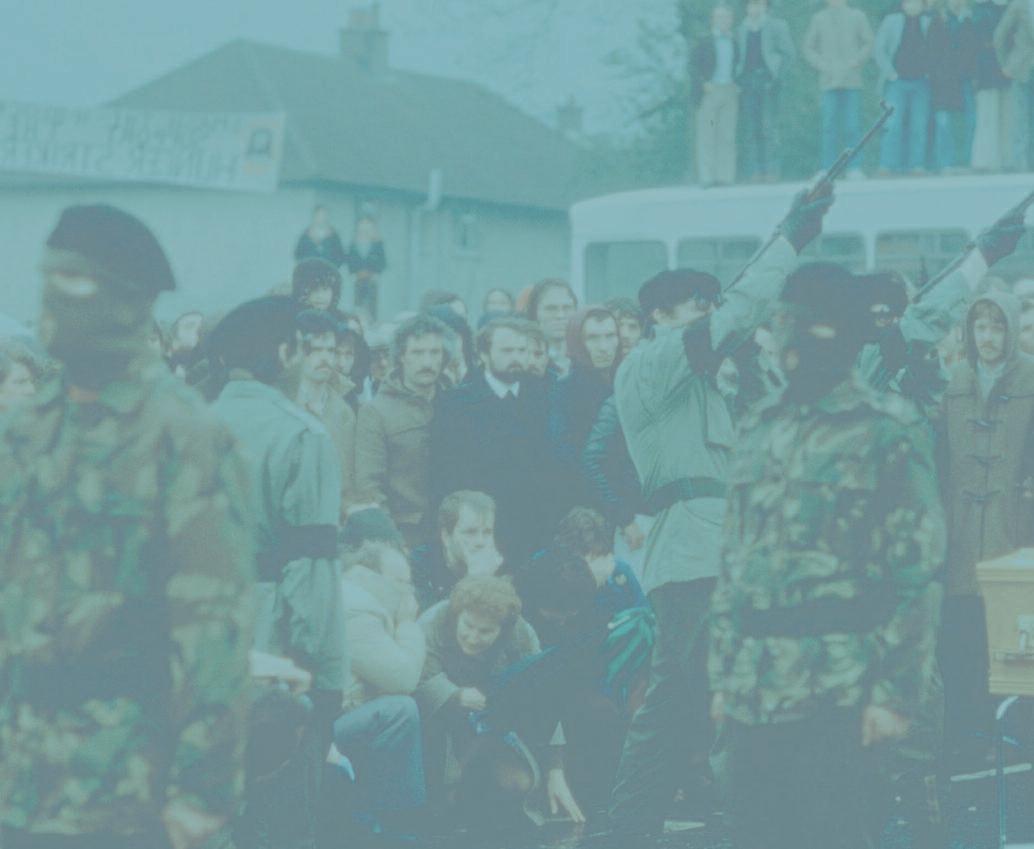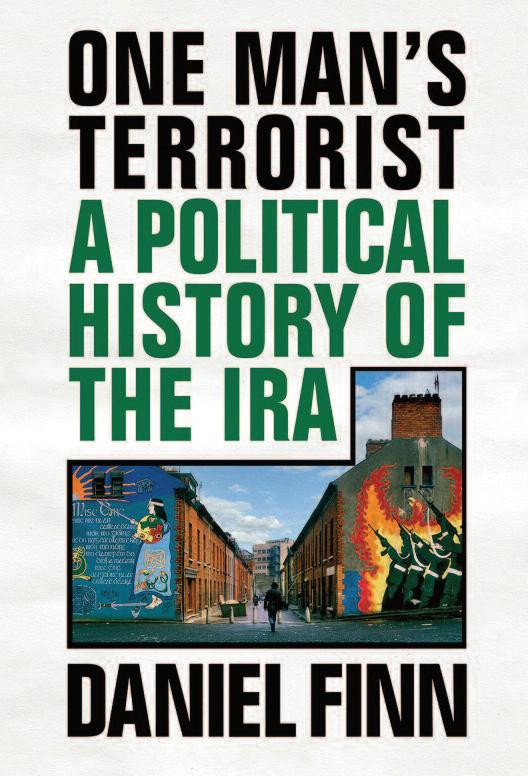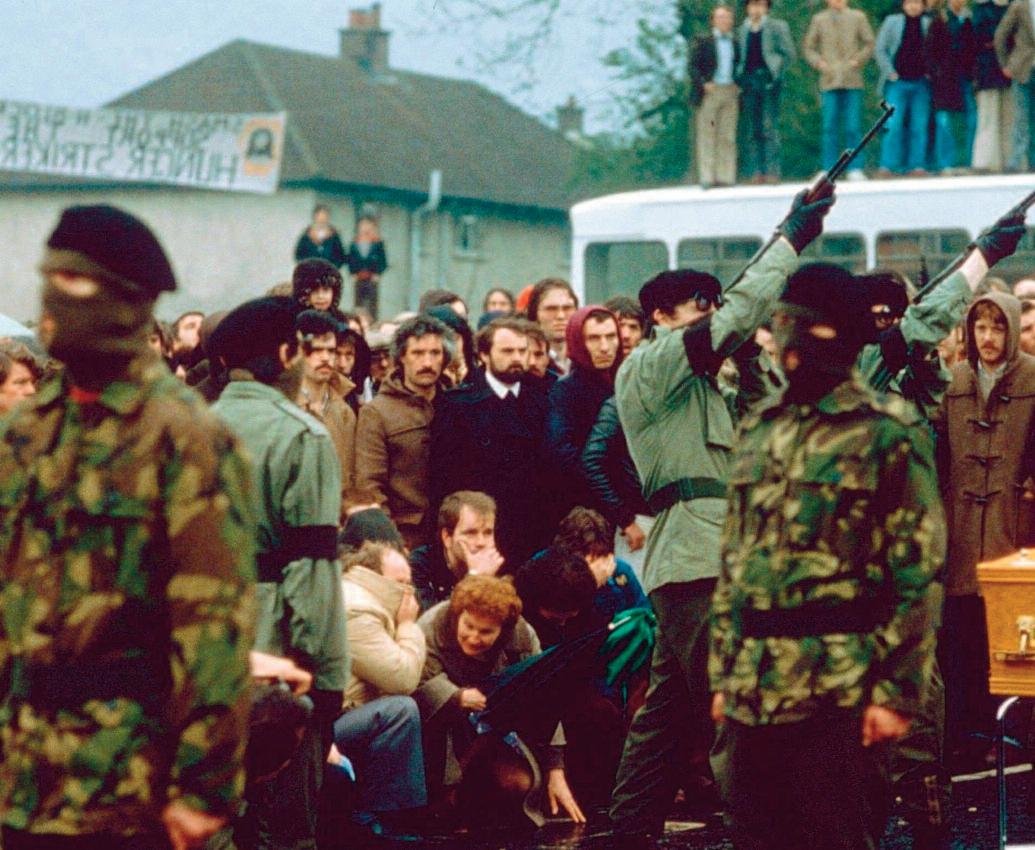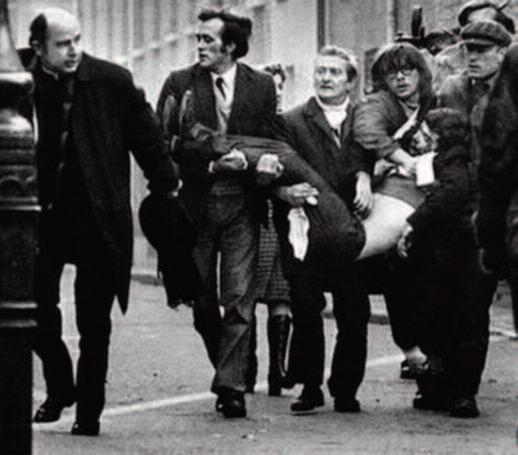
10 minute read
BY SEAN BURNS



review
This year marks the 50th anniversary of the formation of the Provisional IRa. This new book, One Man’s Terrorist: A political history of the IRA, is therefore a timely study of this movement. seán BuRns looks at the book and the lessons that can be learned for today.
Napoleon once said,
“History is a fable agreed upon” . In Northern Ireland, there is no agreed upon history, or rather there are multiple competing accounts. In nearly all of these, the independent role that the working-class has played is written out. Unfortunately, the author of this book also falls into this trap.
One Man’ s Terrorist is an account of the political developments of the Irish republican movement, with a particular focus on the North. The introduction begins with quite harrowing statistics of the death and injury toll during the conflict known as ‘the Troubles’ comparative to the population of Northern Ireland. “They were the equivalent of 125,000 deaths and nearly 2 million injuries in Britain” .
1
This immediately puts the scale of the Troubles into perspective. Many workers and young people lost their lives, and tens of thousands were either injured or imprisoned during the conflict. The severe mental strain placed upon the population has yielded an extraordinarily high rate of suicide and mental health problems which continue to express themselves today. More people have died as a result of suicide since the ceasefires than were killed over the course of the conflict.
The divisions which drove the conflict have not been resolved. They continue to largely define the political terrain in Northern Ireland to this day, more than 20 years after the Good Friday Agreement. The ‘ceasefire generation’ got a taste of the reality of paramilitary violence in the killing of Lyra McKee, a young journalist who was shot dead by a ‘dissident’ Republican gunman during a riot in Derry. Her killing sparked widespread anger. Vigils and protests were organised by her friends and family, as well as sections of the trade union movement. The popular sentiment was ‘no going back’ to the days of the widespread violence.
The armed dissident republicans who continue to wage their “ war” are, on the whole, marginalised but still able to connect with some of the most hardpressed sections of Catholic working-class youth, in areas such as the Bogside and Creggan where poverty and unemployment are facts of life. These are the conditions out of which paramilitarism can redevelop if an alternative is not posed. The existence and
activities of these groups act as a warning of what can develop if there is no resolution to the national question in Ireland. That is a prospect of renewed conflict and sectarian violence.
But this is, of course, not the 1960s or ‘70s. The basis upon which the Provisional IRA was able to sustain and develop itself has greatly diminished. A power-sharing administration between nationalists and Unionists has replaced Unionist dominance in the devolved government. British soldiers have been effectively withdrawn from the streets. Although disparities remain as a legacy of the past, discrimination against Catholics in access to jobs and homes is largely gone. The Provisional campaign was brought to an end partly because of a growing ‘ war weariness’ among the population, given expression by mass protests against sectarian killings and paramilitary activity.
A serious study of Irish republicanism, its armed and political manifestations, is invaluable for socialists and working-class activists to understand the serious limitations and the negative role these ideas and methods have played throughout history. Unfortunately, this is something the author falls short of on a few occasions. The Socialist Party in Ireland bases itself upon the power of the working class and believes that common struggle of working-class people is necessary to change society and end the common misery of sectarian conflict, poverty and oppression that capitalism has to offer us. The forerunner of the Socialist Party, The Militant, at the time consistently opposed the mistaken methods of the IRA and other paramilitary organisations. We argued that the individual terrorist methods of the Provisional IRA were incapable of defeating British imperialism and actually acted to reinforce and increase sectarian division in Northern Ireland.
No stream to swim in
A “fish through the desert” is an aptly named chapter, detailing the isolation that republicanism faced throughout most of the 1950s and 1960s. The attempts of the IRA at the time to wage a “Border Campaign” , where they carried out attacks against police barracks, failed to have any meaningful impact. Likewise, throughout the 1960s, the IRA failed to gain a resonance amongst the population, north or south of the border. This is reflected in the declining membership figures that the author details. However, a question that is not adequately answered in the book is - why was this the case? If the IRA could wage its armed campaign in ‘72, why not in ‘65?
The author, Daniel Finn, identifies some of the reasons. State repression acted as a recruitment sergeant for the IRA. The events of Bloody Sunday in 1972, where British paratroopers gunned down 14 unarmed civil rights protesters in Derry, drove many young Catholics into the arms of the PIRA. They saw in them a vehicle to strike back against the system which meted out acts of brutality and offered them only a future of poverty and unemployment. Throughout the conflict, callous acts of repression by British imperialism would play this role repeatedly.
However a major omission as to why the IRA and other paramilitary forces were unable to gain mass traction throughout most of the 1960s was that working-class people from both Protestant and Catholic backgrounds were beginning to struggle together against the status quo. The author makes some reference to the Northern Ireland Labour Party ’s (NILP) electoral success. But he downplays its significance.

Bloody Sunday 1972: The murders by the British state pushed many Catholic youths into the arms of the IRA
the road not taken
In the 1960s, the NILP, for all its weaknesses, had a mass base of support. In 1962, it gained 62,175 votes in Belfast, compared to 67,350 for the Unionist candidates. This represented 26% of the votes cast. The total left-wing vote in Belfast was 32.8%. Even after the violence of August 1969, the NILP retained mass support and achieved 105,759 votes in the 1970 general election.
The author dismisses Labour’s support politically, and also the prospect of united class struggle. He quotes the promises of “a social & economic revolution” from the old Unionist leadership made at the time and states, “that proved enough to avoid the specter of defeat” , before swiftly moving on.
2
He, in essence, articulates the idea that unity was not possible at this point as a result of promises made to Protestant workers. Contrary to what the author presents, the idea that workers could be united both industrially and politically was not utopian but was a living reality at the time. The 1960s saw the Unionist establishment scramble to tackle the rising class struggle and the increasing unity of Catholic and Protestant workers by resorting to sectarian bigotry.
The most remarkable development in the early 1960s was a generalised shift to the left in society.
Catholic workers saw the IRA and their methods as offering no coherent alternative to the discrimination and poverty that they faced at the hands of the Unionist establishment. Likewise, Protestant workers were increasingly engaging in strike action against their bosses and looking leftwards. The lords and ladies of official Unionism were quick to take note of these developments. For them, their majority was secure so long as Catholics voted for nationalists and Protestants voted for Unionists. The possibility of the labour movement bridging that sectarian divide posed serious issues for them and they responded to its growth with vitriol.
“Employers should consult the unionist register and pick their employees from it” – this is often quoted as an example of the instrangient sectarianism of the Unionist government, but its real significance is often overlooked.
3
It was made on 5th March 1961, just after titanic strikes of both Catholic and Protestant workers rocked the Belfast shipyard. It is not for no reason that the old Unionist regime at the time scrambled to resurrect the “Unionist Labour Clubs” . These associations were designed to tie together Protestant workers under the banner of Unionism rather than class, in order to disrupt the developing unity between workers. They were not to make much impact, however.
civil rights struggle explodes
Young people looked elsewhere for methods to struggle. Events internationally would have an explosive effect. The idea that mass struggle was necessary to enact change, as well as the ideas of socialism and class struggle, were being brought to the fore. From the late 1950s, the black civil rights movement convulsed the United States and, in the ‘long hot summer of 1967’ , riots rocked dozens of cities as the downtrodden rose up in revolt. The year of 1968 was dominated above all by the May revolutionary “evenements” in France. A general strike of ten million workers demonstrated the power of the working class, and President de Gaulle fled the country, openly voicing his fear that the game was up for capitalism. These events displayed clearly the power of class struggle, strikes and mass movements, and were a source of inspiration for young people and workers in Northern Ireland at the time.
The civil rights movement, although predominantly Catholic, gained an echo among Protestant youth, at least initially. They were inspired by what they were witnessing internationally, and outraged at the conditions of discrimniation and poverty that existed at home. An illustration of the rampant poverty in the 1960s was that nearly 100,000 homes were declared “unfit for human habitation” , spanning both Protestant and Catholic areas.
It was the failure of the labour movement to decisively intervene that allowed the so-called ‘moderates’ , such as John Hume, to stamp their authority on the civil rights movement. Hume, a voice for the conservative Catholic middle class, argued vehemently against class or socialist ideas that might ‘split’ his aim of all-class, “Catholic unity. ” This watered down the programmatic demands to those simply demanding more rights for Catholics, an equality of poverty, not the broad class demands that had previously been put forward. This allowed the government to paint it as a movement against Protestants and dissuade broad cross-community from developing. Unionist die-hards such as Paisley were an isolated minority through most of the 1960s, viewed as a rabid fringe element by the majority of Protestant workers. As the civil rights movement became increasingly framed in terms of Catholic rather than class unity, however, they were able to begin to make strides forward.
Likewise, the conservative heads of the NILP and the trade union movement stood aside during the stormy events of 1969. The trade union leadership, heading a 210,000 strong movement of both Catholic and Protestant workers, sat aloof from the turmoil - through months of demonstrations, counter-demonstrations, riots and mounting tension – restricting themselves to praising the Unionist government for the partial reforms that were forced upon them and to issuing sanctimonious pleas for calm.
If they had instead launched a struggle for civil rIghts, decent jobs and housing for all working-class people, as well as challenging the repression being meted out by the Unionist establishment, a united working-class opposition could have been built.
Splits in republicanism
It was in the context of these huge upheavals that leading members of the Southern establishment, including future Taoiseach Charles Haughey, sought to intervene into the situation to protect capitalism’s interests. They were terrified of what was developing behind the barricades in Northern Ireland, with new organisations being thrown up that they had little to no influence over and socialist ideas spreading. Their ‘assistance’ was aimed at buying organisational and political influence so as to limit the movement in the North by harnessing it safely in the halter of Catholic sectarianism and nationalism
They offered £100,000 to supply weapons to the IRA but firm conditions were attached. These were that the ‘socialist’ policies of the IRA should be dropped, that there should be a separate Northern command structure for the IRA , and that all IRA military activity be confined to the North.
The first issue of An Phoblacht sums up the politics of the new Provisional leadership:
“Gradually into executive positions, both in the IRA and Sinn Fein, the Red Agents infiltrated and soon these men became the policymakers. Young men and girls were brainwashed with the teachings and propaganda of the new policymakers and well trained organisers were sent into different areas to spread the teachings of these Red Infiltrators” .










